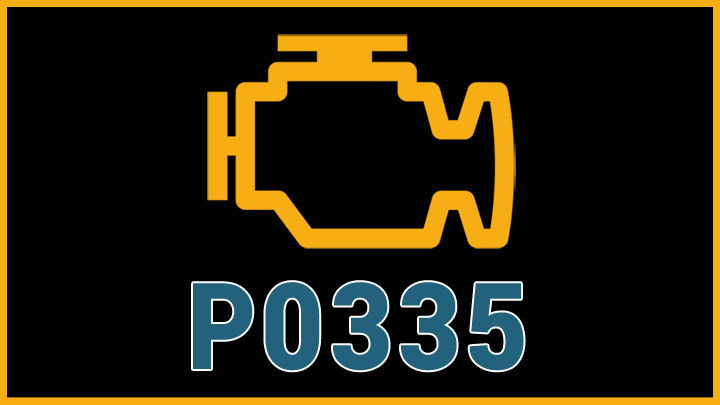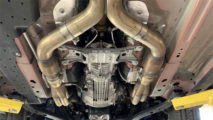Last Updated on April 11, 2022
The purpose of the crankshaft position sensor (CKP) is to measure the rotational speed (RPM) and precise location of the engine’s crankshaft. Without this sensor, you wouldn’t be able to start your vehicle’s engine.
Most car owners don’t know about the crankshaft position sensor until they receive the error code P0335 or the engine dies. Here’s what that code means, symptoms to look for, common causes, and how to fix the issue.
What Does Code P0335 Mean?
This code essentially means that the vehicle’s electronic control module is not able to detect the crankshaft position sensor.
The CKP sensor typically tells the car’s computer how fast the engine is running. The ECM (engine control module) uses this information to know when to inject fuel and when the spark plugs should ignite the air-fuel mixture.
The CKP sensor works in conjunction with a reluctor ring attached to the crankshaft. It tells the ECM where the crankshaft is at any given time. The ring moves in front of the sensor and generates a square wave voltage indicator that the ECM reads as the crankshaft position.
Diagnostic trouble code P0335 occurs whenever the ECM is not able to detect crankshaft pulses. Without accurate readings from the CKP, your engine may exhibit all sorts of problems.
See Also: P0336 Code, P0340 Code, P0341 Code
Symptoms of Code P0335

If you think your crankshaft position sensor has failed, here are some symptoms to look for.
#1 – Slow Response From the Accelerator
As the engine of your car speeds, your ECM should adjust spark timing and fuel injection accordingly. With a faulty crankshaft position sensor, the ECM will not be able to make these adjustments, resulting in slow acceleration problems.
#2 – Reduced Gas Mileage
Without proper timing information, fuel injection will not occur as efficiently as needed. As such, the engine will use more gas than usual and your wallet will get lighter.
#3 – Engine Misfires
A faulty crankshaft position sensor causes improper spark timing, which can lead to different problems, including the misfiring of one or more engine cylinders. You will feel or hear this as a brief stutter in the engine.
#4 – Engine Dies and Does Not Restart
Without proper amounts of fuel, it may be hard to get your engine to start. If the crankshaft fails and is not sending a signal to the ECU, this will leave your car unable to start.
#5 – Rough Idling or Engine Vibration
You may feel that the engine runs rough or vibrates even at idle, like when you’re sitting at a red light. Poor spark timing causes this issue.
#6 – Check Engine Light Illuminated
A faulty CKP sensor may cause the Check Engine Light on your dashboard to light up. This light, however, doesn’t usually come on immediately. Therefore, you may experience any of the above symptoms long before it illuminates.
Causes of Code P0335

- Faulty or damaged crankshaft position sensor
- Broken timing belt
- Malfunctioning engine control unit
- Damaged reluctor ring
- Faulty crankshaft position sensor connections or wiring
- Rough running or a misfiring engine
Is Code P0335 Serious?
Code P0335 is serious and should be fixed immediately. This trouble code can cause major internal mechanical drivability issues. You must have the issue fixed immediately to prevent any further damage to your engine.
How to Fix

- Use a live scan tool to check whether the RPM is working while the engine is still running. If you don’t find a problem, conduct a visual checkup of the crank sensor, wiring bind, and connectors to see if there are any signs of damage or fraying to the wiring.
- Check the reluctor ring and timing belt for damage. Replace or repair as needed. If you don’t see any damage, remove the CKP sensor and inspect it for any metal shavings or other damage. You can wipe away the metal shavings to get it working. If the damage is severe, it should be replaced.
- Test the wires of the crankshaft position sensor using a digital multimeter set to DC voltage at a low range. Test each wire to read a reference voltage of 1.5 volts. If a wire doesn’t match these readings, it is faulty and needs replacing.
- If the wiring is OK, use the multimeter to test the sensor. If this does not rectify the error, check the crankshaft position sensor 5-volt square wave pattern. Reference your car’s repair manual to know which reading is sufficient.
- If the reading is within the specs of the vehicle, there is no need to replace the crankshaft position sensor. If the reading is not within the specifications, you will need to replace the crankshaft position sensor.
- If these steps do not fix the problem, your car may be having more serious electrical or mechanical issues. Take it to and ask a professional mechanic for further diagnosis.
The crankshaft position sensor is crucial to proper engine functionality and performance. It provides vital signals that your car’s computer uses for engine management calculations.
As such, issues with the crankshaft position sensor can quickly lead to issues with the drivability of your vehicle. Therefore, in case of the error code P0355, the vehicle needs to be inspected by a professional technician immediately.




How to test ckp sensors via multimeter and what is the normal value during reading thanks
Here are a couple videos that do a good job explaining:
my po335 light is not going off after repacing both sensors from agents Nissan almera
what must I do/
You may have to do some electrical diagnostics to determine if it’s a wiring issue that’s throwing the code, not the sensor itself.
I rebuilt my engine with a new crankshaft, replaced a 1.4 with a 1.6 crankshaft now the car is not revving mostly importantly it is no longer starting, bought a new crank position sensor still not working compared the number of teeth as well as the length of the two crankshafts every is the same only the stroke as well as the conrods differ, still no luck
Are you absolutely sure those two crankshafts are compatible? When you replace a crankshaft, usually you have to do some machining and careful selection of rod bearings to make sure the clearances and tolerances are all correct. Did you perform this step?